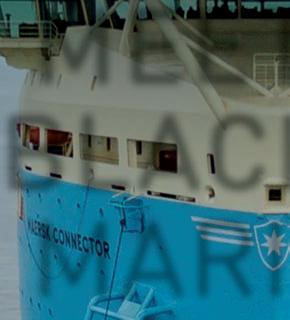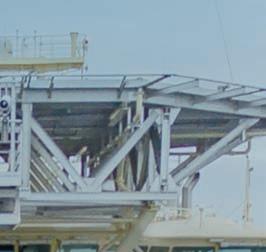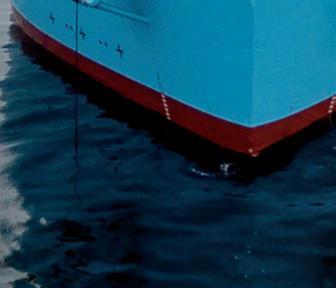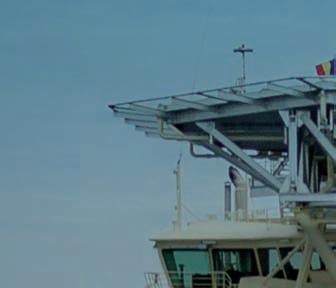
6 minute read
PSV Converted to Fish Feed Carrier
Damen Gives new Life to surpLus pLatform suppLy vesseL
eiDsvaaG, the norweGian company that speciaLises in the Distribution of fish feeD, has contracteD Damen to carry out a conversion project. Damen shiprepair amsterDam (Dsam) is converting a platform supply vessel (psv) into a fish feed carrier that will improve efficiency and sustainability in the norwegian aquaculture industry.
All photos courtesy of Damen.
Work is underway at Damen Shiprepair Amsterdam to convert platform supply vessel World Opal to fish feed carrier Eidsvaag Opal.
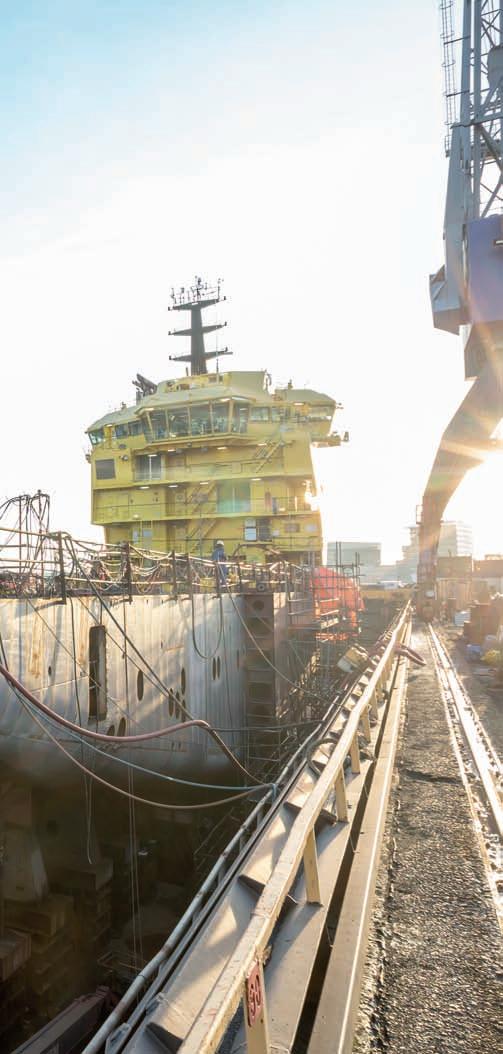
The aquaculture industry has been growing rapidly in importance in recent decades. as the global population has grown, a combination of the rising living standards and an increasing levels of health consciousness has driven a growing demand for seafood. this demand can in part be met thanks to advances in technology. aquaculture as an industry has grown significantly so that, in 2019, farmed fish accounted for 50% of all seafood consumed around the world. it won’t stop here though. With the world’s population set for continued growth, the Global aquaculture alliance (Gaa) is predicting a significant increase in demand for farmed fish and seafood in the years ahead. it is their estimate that, by 2030, as much as 62% of all fish consumed will be farmed – an indication of growth at an exponential rate. this is equivalent to 93.6 million tonnes of fish consumed per annum, which is a 100% increase on the amount consumed in 2006.
Meeting the Challenge eidsvaag is a small, family-owned norwegian company that has been transporting fish feed to the aquaculture sector since the early 1980s. in 1995, as the aquaculture industry expanded, the company switched from road transportation to shipping, and now operates a fleet of sixteen privately owned and chartered vessels. From its inception, eidsvaag has provided its services to skretting, one of the world’s biggest fish feed producers. Last year, in the pursuit of more sustainable operations, skretting reached an agreement with competitor cargill to vessel share for the distribution of fish feed in norway. the collaboration, named Fjordfrende will reduce greenhouse gas emissions across the operations of both companies by one fifth. this is the same as removing 7,500 cars from the road with a resulting reduction of some 10-20 million kg of co₂ annually. to fulfil its contractual obligations, eidsvaag will require an increase in tonnage. this is a trend across the aquaculture sector where the increasing demand is driving shipbuilding activity. it has been a benefit for the maritime industry at a time when some of the more traditional markets such as the offshore oil and gas industry are underperforming.
New Life for PSVs Damen was quick to notice this development and suggested back in 2016 that laid up platform supply vessels could potentially be converted to serve more >>
In total, 650 tonnes of new steel will be installed in Eidsvaag Opal while she is in drydock.
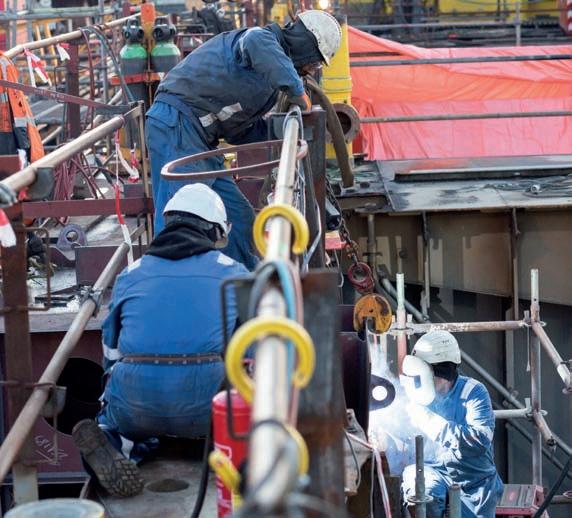
active markets. eidsvaag was one of the first companies to see the potential and purchased the 80m, 3,300 DWt psv previously known as World opal. the company then put the conversion of the psv to a fish feed transportation ship out to tender. Damen’s bid for the project was spearheaded by eirik eide, Damen’s sales manager for norway who is based in stavanger. “since we established the office here in stavanger in 2012, we have seen the growing importance of the aquaculture sector to the local economy”, explains mr eide. “that, alongside the country’s sizeable footprint in offshore energy as well as other maritime activities makes it an important market for Damen. over the past eight years, our combination of high quality, competitive pricing and short delivery times has enabled us to sell a variety of vessels to local operators.”
A Complex Project converting psv World opal into fish feed transportation vessel eidsvaag opal is a complex project, which involves a series of major works. the vessel has to be cut in half in order to add an additional five metres to its overall length. the beam is also to be increased to give additional stability and cargo capacity using a series of side boxes 1m across. additionally, 32 new steel sections will be built into the main hull to allow the vessel to carry a range of different fish foods. the 35 new integrated silos and a newly added big bag hold together will allow the vessel to carry 2,800t of fish food. Five new cranes will be installed along with a large discharge system made up of conveyors, buckets, elevators and a discharge arm. the tender was won by Damen shiprepair amsterdam (Dsam), which was the most suitable yard in the group for the project, based on its facilities and its proximity to niron staal, Damen’s specialist steel fabricator. and the conversion does involve a lot of steelwork. “one of the main things that made Damen stand out as a strong candidate in the tender process was their previous experience with the vessel”, explains vidar eidsvaag, general manager and owner at eidsvaag. World opal,
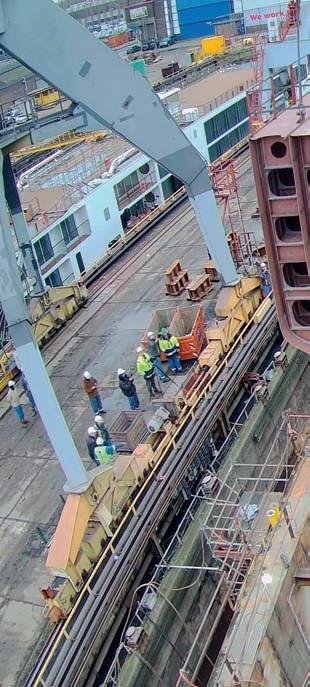
now renamed eidsvaag opal, was built by Damen and supplied to offshore supply company World Wide supply in 2013 as part of a six-vessel order.
Conversion Already Underway the eidsvaag opal arrived at the yard in the final weeks of 2019, where the stripping soon got underway. the first order of business was the removal of the main deck, after which the vessel was cut in half. subcontractor mammoet then moved the aft section of the vessel ten metres back in order to allow space for the fitting of the new 4.9-metre section. in total, 650 tonnes of new steel will be fabricated by niron staal and installed in eidsvaag opal while she is in
The vessel has been cut in half in order to add an additional five metres to its overall length.
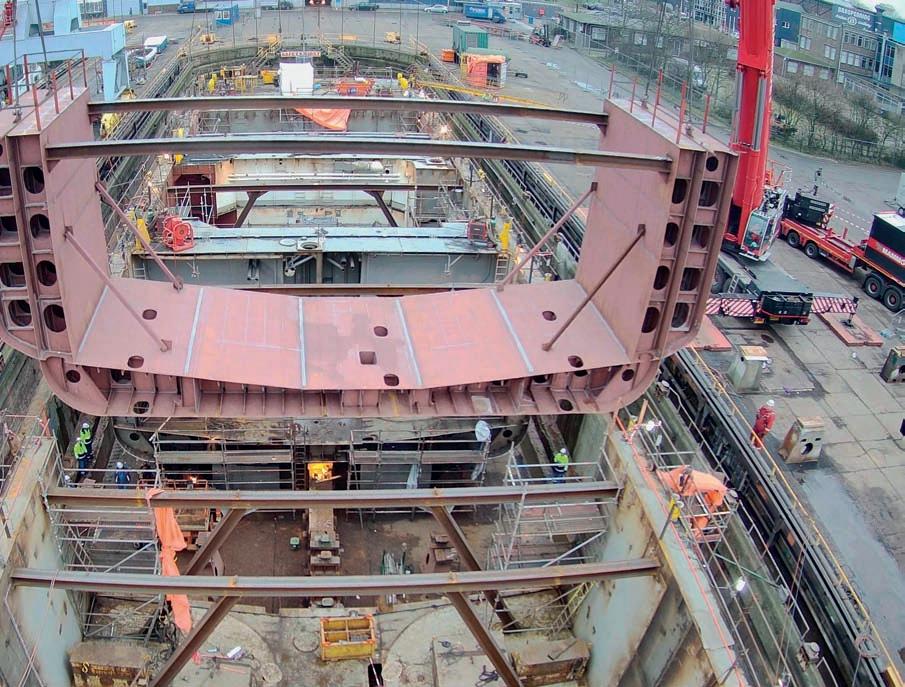
drydock at DSAm. 300t of redundant ship’s structure will also be removed as part of the conversion process. “The fact that Damen is familiar with the design of the ship, is really helping to speed up the project”, continues Vidar. “Of course, there were other reasons for their success in the tender process. In addition to knowledge of the actual vessel, Damen was able to demonstrate the successful completion of a relevant conversion for the aquaculture industry.” Damen’s previous track record includes the conversion of a Damen Combi Coaster into a fish feed transportation vessel. This involved the shipbuilder shortening the vessel in order to provide the added manoeuvrability
necessary for operating within fish farms. The vessel was then outfitted with 64 silos for the transportation of different types of fish food. “We really appreciate the close cooperation that we have with the client”, says Tjeerd Schulting, managing director at DSAm. “We sailed with the client for a trip, which is something that we do not often have the opportunity to do, and it gave us a close understanding of the way the client works. This project really is a joint effort between the client and us.”
i. damenshiprepair.com i. eidsvaag.no

